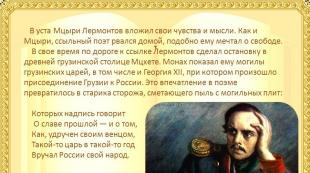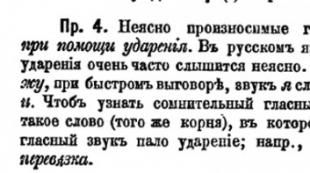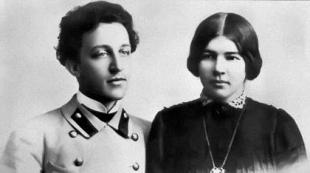Adverb in Russian. What are adverbs in the Russian language, their formation and role in a sentence A message about an adverb as a part of speech
§1. General characteristics of the adverb
An adverb is an independent part of speech.
Adverbs are a heterogeneous class of words. It includes indeclinable, inconjugable and inconsistent words. Adverbs are added to other words. Most adverbs are significant words, for example: yesterday, left, in the morning, into the distance, very, but there are also pronominal ones, for example: there, where, where, everywhere (there- index, where, where- interrogative and relative, everywhere- determinative). Pronominal adverbs have the form of adverbs, and the role of pronouns. Pronominal adverbs are among the most ancient.
The class of adverbs is replenished with words from different parts of speech: nouns, adjectives, verbs, numerals. Becoming an adverb, a word loses the characteristics characteristic of other parts of speech, becomes unchangeable, and is used as a stamp.
1. Grammatical meaning- a sign of a sign, a sign of an action, less often - a sign of an object.
Very beautiful is a sign of a sign,
Funny laughing is a sign of action,
Coffee in Turkish- a sign of an object.
Adverbs answer different questions. It is more rational to present them below, when the categories of adverbs by meaning are considered.
2. Morphological characteristics:
- constants - immutability,
- changeable - degrees of comparison (only for adverbs formed from qualitative adjectives: good - better, beautiful - more beautiful).
3. Syntactic role in a sentence- adverbial or predicate in two-part sentences.
We got the job done quickly.
She is married.
Note:
Important information regarding words on -0- in impersonal sentences is given in this chapter at .
§2. Places by value
1. Circumstantial:
1) places (where? where? from where?): on the left, in the distance, above, there, there, below ,
2) time (when? how long?): in spring, yesterday, then, when, long,
3) reasons (why?): rashly, foolishly, stupidly, because
4) goals (why? for what purpose? for what purpose?): why, then, out of spite.
2. Determinatives:
1) qualitative, or mode of action (how? in what way?): fun, slowly, like that, three of us,
2) quantitative, or measures and degrees (to what extent? how much?): very, not at all, three times.
The category of qualitative adverbs is the most numerous.
§3. Qualitative adverbs in -о//-е. Degrees of comparison
Qualitative adverbs are formed from qualitative adjectives using the suffixes -о or -е.
Like adjectives, such adverbs have degrees of comparison, which show how the attribute is manifested: to a greater (smaller) or to the greatest (smallest) degree.
Examples:
- positive degree: The son sings loud.
- comparative degree: The son sings louder, than usual. Son sings louder than his friend.
- superlative: The son sings loudest.
Like adjectives, adverbs have degrees of comparison: simple and compound.
The simple comparative degree is formed using the suffixes: -ee-, -ey-, -e-, -she-, for example:
fun - more fun (more fun),
easy - easier,
thin - thinner.
The compound form of the comparative degree of adverbs is formed by a combination of words more or less and adverb forms in the positive degree, for example:
more thin, less easily, more clearly, less bright.
The superlative also has a simple and a compound form, but in modern language the compound form is more common. It is formed using the words: most or least: most seriously, least brightly, as well as words everyone And Total, for example, more seriously everyone tastier Total.
Note:
After the words most And least the adverb is used in a positive degree, and before words everyone And Total adverb - to a comparative degree.
Simple superlative adverbs are found only in some stable combinations: most humbly, most humbly, most deeply, most respectfully I beg.
For some adverbs, the degree of comparison is a constant feature.
You more Don't write to me. You better Don't write to me.
Here are the words bigger, better are not degrees of comparison.
Usually adverbs in the comparative or superlative degrees of comparison express the same meaning as an adverb in the positive degree: The son sang louder(even more loud, value component loud relatively preserved).
In the above examples: You to me more do not write ( more does not mean: a lot of). You to me better do not write ( better does not mean: Fine)
§4. What to count with what? Adverbs and words of state category
As always, this section discusses various interpretations, opinions, and points of view.
What is the problem? What's being discussed?
There is a group of words in a language that have certain features.
These words denote the state of nature or man:
On the street Cold. To me Cold.
Formally, this group combines words with the suffix -o, formed from qualitative adjectives and having degrees of comparison.
It got cold outside . On the street colder than at home. It was coldest on the first floor.
From the examples it is clear that in a sentence these words are part of the predicate in impersonal sentences.
Traditionally, this group of words was considered as a group of special adverbs and was not identified as a separate part of speech. A number of authors highlight a special part of speech in their textbooks. They call it differently. Most often, following Academician V.V. Vinogradov - condition category. Other names for this group of words are also known: predicative adverbs, words of condition and even state name.
- To her Cold(cat. condition).
- She answered Cold(adverb).
- Her face was Cold , there was not even a shadow of a smile on him (short adjective).
Words: you can, you can’t, it’s a shame, it’s time, it’s a pity and other similar homonyms among other parts of speech do not have. They are used only as part of a predicate impersonal sentence and belong to the category of state.
An alternative view defines these words as a special subgroup of adverbs. In this case, in order to maintain consistency, it is necessary to understand that adverbs in a sentence can be an adverb, some adverbs can be an adverb and a predicate in an impersonal sentence, and some can only be a predicate in an impersonal sentence.
There was a forest to the right.
She answered coldly.
She felt cold.
I was ashamed.
Test of strength
Check your understanding of this chapter.
Final test
Is it correct to believe that adverbs include indeclinable, inconjugable and inconsistent words?
What is the syntactic relationship between adverbs and other words?
- Coordination
- Control
- Adjacency
Are all adverbs significant words?
Which adverbs have an inconstant (changeable) sign of degree of comparison?
- Everyone has
- In adverbs formed from qualitative adjectives
What suffixes are used to form adverbs from qualitative adjectives?
- Suffixes -o- or -e-
- Suffixes -mu- (-him-)
- Suffix -yh- (-their-)
To what extent are qualitative adverbs the feature manifested to a greater or lesser extent?
- To a positive extent
- To a comparative extent
- Superlative
To what extent is the characteristic of qualitative adverbs manifested to the greatest or least degree?
- To a positive extent
- To a comparative extent
- Superlative
What category of meaning do the adverbs belong to: rashly, foolishly, out of stinginess, out of stupidity, out of ignorance?
- Time
- Causes
What category do adverbs belong to: fun, slow, fast, threesome?
- Quality
- Quantitative
Learning parts of speech in Russian lessons is quite difficult. The morphology section “Adverb” causes especially great difficulties.
To make it easier for students to master basic concepts, it is necessary to structure lessons in such a way that the student’s interest does not wane. When all the material has been studied, you can summarize and repeat the most important thing, to put together a complete picture about the adverb.
A presentation on the topic “Adverb” reveals this difficult topic for students in an easy and accessible way, with vivid examples and interesting tasks.
Working with the proposed tasks, writing out adverbs from a literary text, students repeat the concept of an adverb, its semantic groups, methods of formation, main features, syntactic role, and spelling rules.
The presentation was prepared specifically for a generalization and repetition lesson in 7th grade as preparation for a test on the topic “Adverbs.” The presentation will help the teacher organize tasks for the lesson in the required form, which is quite accessible for working with the class.
Description of the slides.
1. Title slide.
2. What does the adverb mean?
Adverb denotes attribute
actions: run slowly, speak quietly;
characteristic: very soft, flashy, quite provocative;
item: opposite house, soft-boiled egg.
3. Determine the meaning of adverbs.
- There is only snow lurking here and there.
- Everything around is asleep.
- The sun will come out in the morning and rise high into the sky.
- A slightly wrong step - knee-deep.
- There is still a lot of snow in the birch forest.
- Yesterday Grandfather Frost left us along this ski track.
- Skates are not available for rental.
4. Classes of adverbs by meaning.
|
Mode of action |
How? How? |
|
Where? Where? Where? |
|
|
When? How long? |
|
|
Measures and degrees |
How many? To what extent? |
5. Examples.
Mode of action: softly, strangely, monstrously, scary, quickly, galloping, on foot, swimming, mixed up, idly, backhand, for sure.
Time: spring, winter, autumn, yesterday, today, tomorrow, morning, afternoon, evening, night, sometimes, now, always, immediately.
Goals: out of spite, in defiance, as a joke, intentionally, unintentionally, accidentally.
Causes: foolishly, blindly, rashly, involuntarily, not without reason.
Measures and degrees: a lot, a little, a little, doubly, triple, twice, thrice, two, three, six, very, very, completely, absolutely.
6. Determine the category of adverbs.
Wood grouse have moved closer to the aspen trees.
Now you won’t see a bullfinch or a blackbird in the Christmas trees.
There were a lot of spruce cones this year.
Spruce scales will fly down, straight into the snow.
Who feeds on spruce seeds and sings songs as if nothing had happened?
Crossbills quickly hang on the branches and immediately fall silent.
It is rare for a crossbill to deal with a cone even halfway.
7. Two groups of adverbs.
There are significant adverbs: they name some sign directly (quietly, loudly, in the evening).
There are pronominal adverbs: they do not name a characteristic, but only indicate:
on the mode of action (so, somehow, somehow),
time of action (then, then, sometime),
reason (because, therefore, for some reason),
goal (then, for some reason).
8. Methods of forming adverbs.

9. Determine the method of forming adverbs.
1 option
Singingly, then, in the distance, somehow, little by little, with a step, like a wolf, forward.
Option 2
Scattered, at random, apparently, then, immediately, crosswise, therefore, to the right.
10. Formation of comparison forms.

11. Form forms of comparison.
- Strongly.
- Fast.
- High.
- Tasty.
- Low.
- Directly.
- Left.
From what adverb is it impossible to form forms of comparison?
12. Syntactic role.
DEFINITION:
Important events took place in the house opposite.
CIRCUMSTANCE:
There was silence all around.
He looked at me slyly and fox-like.
PREDICATE:
She is not married.
13. What parts of the sentence are adverbs?
- Mom looked a little tired.
- Not a single person is visible around.
- In spring, all nature comes to life.
- We ate meat the French way.
- Somewhere very far away a storm began.
14. Self-test.
15. The role of adverbs in the text.
Individual artistic details (metaphors, personifications, epithets) are emotionally colored.
The description as a whole is clarified and specified (indicating the time, place, mode of action, its purpose, measure and degree).
16. Write down the adverbs with the words they define.
It's already evening. The setting sun blazes brightly on the horizon. A warm breeze blows (not) boldly. The sunset looks amazingly beautiful and colorful.
We are standing on the top of a hill, and the sea is quietly splashing below. In the distance is the white sail of a fishing boat. Twilight (un)noticeably sets in, it gets sharply dark, and in the evening sky (un)expectedly a lu(n,nn) disk appears.
17. Self-test.
18. Spelling adverbs
NOT with adverbs
b after hissing
Hyphen-combined-separate
O and A at the end of adverbs
O-Y after pinching
НН-Н in adverb suffixes
19. NOT with adverbs ending in -o, -e.
It is written separately if there is a contrast with the conjunction a: Not good, but bad (fighting is not good).
If the adverbs include the words far from, not at all, not at all, not at all, not at all: This is not interesting to me at all.
20. b in adverbs after hissing ones.
It is ALWAYS written: backhand, backwards, all over.
Exceptions: already married, unbearable.
21. Hyphen in adverbs.
a) A hyphen in adverbs is written after the prefixes -, in-, in-, if these words contain the suffixes -mu, -im, -yh, -ih, -i: secondly, as before, in my opinion, in Russian, in summer.
b) After the prefix koe- and before the suffixes -to, -or, -ni: some where, somehow, somehow.
c) In complex adverbs formed with the help of words of the same root or by repetition: white-white, exactly, a little.
22. The letters -O, -A at the end of adverbs.
Use the word "window"! Works with the prefix-suffix method of adverb formation!
Left (out the window), Right (from the window), FROM THE WINDOW (from the window).
But: trusting, intelligible, fair.
23. -O, -E after hissing adverbs at the end.
The letter O is written under the accent: hot, fresh.
In the unstressed position - the letter E: brilliant, simpler.
Exception: yet.
24. N and NN in adverbs.
enthusiastically - enthusiastic (adv.)
strongly – strong (adj.)
scattered - scattered (adv.)
terrible - terrible (adj.)
intensely - intensified (adv.)
absolutely – perfect (adj.)
interesting – interesting (adj.)
25. TRAINING.
Insert b where necessary:
Hide.., wide open.., sword.., youth.., look.., already.., completely.., powerful.., fresh.., backhand.., married.., etc.., trifle. ., carcass.., mouse.., rags.., penny.., gallop.., unbearable...
26. Self-test.
27. Together or separately?
(Not) far from the house there grows an oak tree.
The soul is (not) cheerful, but very sad... but.
We talked not at all loudly.
The work was done (in)carefully.
The boy is dressed (not) sloppy.
The music sounded (not) loud.
28. Self-test.
29. E or I? Put the emphasis!
36. Self-test.
37. N or NN? Determine the part of speech!
Vzvolnova...to talk.
I looked crazy.
He screamed desperately.
The guys' attention is scattered..o.
The wind scatters the seeds across the field.
Slowly he walked through the city.
The roofs of the houses were white with snow.
Karti..o akimbo.
38. Self-test.
39. If you don’t understand something, ask! Wrong - repeat!
Adverb (part of speech)
Adverb- this is an independent part of speech that is not inflected or conjugated. Indicates a sign of action (driving fast, rotating slowly), a sign of a condition (very painful), a sign of another sign (extremely cold), and rarely a sign of an object (soft-boiled eggs). In a sentence, an adverb is usually an adverb and answers the questions how? how? in what degree? to what extent? Where? Where? where? When? Why? For what? or agreed upon definition. Adverbs are organized into phrases according to the type of connection - adjacency. When characterizing adverbs from the point of view of morphology, it is necessary to indicate the absence of a paradigm of conjugation and declension. But it would be inconsistent to talk about the complete immutability of adverbs: adverbs formed from adjectives, in many cases, retain the ability to form forms of comparison and forms of subjective assessment of quality. So adverbs can have three degrees of comparison: positive, comparative, superlative. Comparative and superlative are formed either synthetically or analytically.
In russian language
Classification by lexical meaning
- Circumstantial:
characterize spatial, temporal, causal and target relationships.
- time- indicate the time of action ( yesterday, today, tomorrow, morning, afternoon, evening, night, spring, sometimes, now, later, later)
- places- indicate the place where the action takes place ( far, nearby, in the distance, near, here, there, to the right, to the left, back, from a distance, towards, from the side)
- causes- indicate the reason for the action ( blindly, rashly, foolishly, drunk, involuntarily, not without reason)
- goals- indicate the purpose of the action ( on purpose, on purpose, out of spite, in defiance, as a joke, intentionally, unintentionally, accidentally)
- Definitive:
- quality- express a characteristic or assessment of an action or attribute ( cold, brutal, sad, strange, monstrous, scary, fast, correct.)
- quantitative- determine the measure or degree of manifestation of an action or sign ( a lot, a little, a little, doubly, triple, twice, thrice, two, three, six, very, very, completely, absolutely)
1) measures and degrees; 2) a certain amount; 3) indefinite quantity.
- method and mode of action- indicate the method of performing an action ( running, galloping, walking, swimming, shuffling, idling, supine, for sure)
- comparisons and likenings - (womanly, bearish, old, our way, friendly, still, nose hooked, upright, squiggle, on end, hedgehog, pillar)
- totality or compatibility - (two, three, publicly, together)
Qualitative adverbs formed from qualitative adjectives have degrees of comparison
- comparative degree is expressed:
- synthetically: using the suffixes -ee(s), -she, -e - more interesting, longer, stronger, louder. Some adverbs form the comparative degree suppletively, that is, changing the basis - good - better, much - more, little - less
- analytically: using the auxiliary word more in combination with the original form of the adverb - more strongly, more interesting, more sad, etc.* superlative
- The superlative degree is expressed:
- synthetically (Greek) sophos - sophotata): wisely - wisest of all; using the suffixes -eysh-, -aysh- - ( I humbly ask, I bow to you most humbly). Very rarely used in modern Russian.
- analytically: by combining the word most with the original form of the adverb - ( most interesting, most vivid, most offensive, etc.) It has a bookish connotation and is used mostly in the scientific style of speech and journalism.
- complex form: combination of words everyone, everything with the synthetic form of the comparative degree - best of all, best of all, most of all
There are adverbs significant, if they are formed from significant words, that is, if adverbs name some attribute directly ( quiet, loud, evening).
There are also adverbs pronominal, that is, if the adverb does not name a characteristic, but only points to it, that is, to a manner of action ( So), locations ( there, here, here, there), time of action ( then, then then), reason ( because, therefore), target ( then).
In the Russian language, significant adverbs predominate.
Classification by method of education
- suffixal: fast - quickly, creative - creatively;
- prefix-suffixal: dry - dry, inside out - inside out;
- prefix: good - bad, where - nowhere;
- addition of different types:
- addition of words: barely, barely - barely;
- addition with the first element semi-: semi-lying;
- addition with the addition of a suffix or prefix and suffix: to walk by - in passing; gender, strength - half strength.
Exceptions and misconceptions
- SUBSEQUENTLY - Later, after some time, after, when. Then.
Subsequently is an exception and, contrary to popular misconception, is written only together, unlike similar adverbs with prepositions (during, in consequence/and, in mind, etc.)
Adverbs in other languages
Literature
- "Modern Russian Language", ed. D. E. Rosenthal
Lectures by Inga Anatolyevna Slavkina
Media:Example.ogg
Wikimedia Foundation. 2010.
See what “Adverb (part of speech)” is in other dictionaries:
ADVERB, part of speech, class of full-meaning words, unchangeable or changeable only by degrees of comparison. Indicates a sign of an action (state) or quality. In a sentence, it usually acts as an adverbial... encyclopedic Dictionary
Adverb (calque of the Latin term adverbium; Latin ad to, with, on and verbum speech), part of speech, class of full-meaning words, unchangeable or changeable only by degrees of comparison (and these contrasted with other full-meaning words), as a rule... ... Great Soviet Encyclopedia
This term has other meanings, see Part of speech (meanings). This article needs to be completely rewritten. There may be explanations on the talk page... Wikipedia
Part of speech- ▲ type of word parts of speech grammatical types of words. substitution words for part of a sentence. significant parts of speech. names verb adverb. adverbial. adverbialization. function words. auxiliary parts of speech. union. concessionary alliance... ... Ideographic Dictionary of the Russian Language
This term has other meanings, see Particle. A particle is an auxiliary part of speech that introduces different meanings, shades into a sentence or serves to form word forms. Contents 1 General properties of particles 2 Particle discharges ... Wikipedia
A participle is an independent part of speech or a special form of a verb. There are participles, for example, in Russian and Hungarian, as well as in many of the Eskimo languages (Sirenix). Participle is an independent part of speech, which has both characteristics ... Wikipedia
This term has other meanings, see Union. A conjunction is an auxiliary part of speech, with the help of which parts of a complex sentence, or homogeneous members of a sentence, are connected. Classification by structure simple (as if) ... ... Wikipedia
Adverb (part of speech) Adverb (dialect) A list of meanings of a word or phrase with links to relevant articles. If you came here from... Wikipedia
Part of speech, a class of full-valued words, unchangeable or changeable only by degrees of comparison. Indicates a sign of an action (state) or quality. In a sentence, it usually acts as an adverbial... Big Encyclopedic Dictionary
This is a part of speech that denotes a sign of an action or a sign of a sign. Contents 1 Groups of adverbs 2 Degrees of comparison ... Wikipedia
Books
- Russian language. 7th grade. Textbook in 3 parts. Federal State Educational Standard, Granik Henrietta Grigorievna, Borisenko Natalya Anatolyevna, Bondarenko Stella Morisovna, Vladimirskaya Galina Nikolaevna. The textbook is part of the new educational complex, which implements the idea of continuity of education from 1st to 9th grade and ensures the achievement of the main goal of studying the Russian language - the education of cultural…
Adverb- this is an independent part of speech, denoting a sign of an action, sign, state, rarely - an object. Adverbs are unchangeable (with the exception of qualitative adverbs in -о/-е) and are adjacent to a verb, adjective, or another adverb ( fast run,Very fast,Very fast).
In a sentence, an adverb is usually an adverb.
In rare cases, an adverb can be adjacent to a noun: running a race (the noun has the meaning of action), a soft-boiled egg, Turkish coffee. In these cases, the adverb acts as an inconsistent definition.
There are two categories of adverbs based on meaning - definitive And circumstances.
Determinative adverbs characterize the action itself, the attribute itself - its quality, quantity, method of execution ( very, beautiful, fun, in my opinion, on foot ) and are divided into the following categories:
- course of action(how? in what way?): quickly, just like that, together ;
- measures and degrees(to what extent? how much?): very, not at all, three times;
- places ( Where? Where? where?): on the right, up there ;
- time(when? how long?): yesterday, then, in the spring, when ;
- causes(Why?): in the heat of the moment, why, because ;
- goals(Why? What for?): out of spite, why, then .
Grammatical features of adverbs
The main morphological property of adverbs is their immutability- this is their constant morphological feature.
However, qualitative adverbs in -о/-е, formed from qualitative adjectives, have degrees of comparison.
Due to its immutability, an adverb is associated with other words in a sentence adjoining. In a sentence it usually happens circumstance.
Some adverbs can act as a nominal part of predicates. Most often these are predicates of impersonal sentences (At sea quiet ), however, some adverbs can also serve as predicates of two-part sentences (The conversation will be frankly u. She is married ).
Adverbs that act as predicates of impersonal sentences are sometimes separated into an independent part of speech or into an independent category within an adverb and are called words of the state category (state words, predicative adverbs).
Degrees of comparison of qualitative adverbs with -о/-е
Degrees of comparison of adverbs, like degrees of comparison of adjectives, indicate greater/lesser or greatest/smallest degrees of manifestation of a characteristic. The structure of degrees of comparison of an adverb and an adjective is similar.
comparative
The comparative degree of an adverb denotes a greater or lesser degree of manifestation of a characteristic:
Petya is running better than jumping.
The child runs slower than an adult goes.
Like an adjective, The comparative degree of an adverb can be simple or compound.
Simple comparative degree adverbs are formed as follows:
base of the positive degree without -o (and without segments k/ok) + formative suffixes -ee(s), -e, -she/-zhe ( warmer, louder, earlier, deeper ).
From the simple comparative degree of an adjective to the simple comparative degree of an adverb differs in syntactic function: an adverb occurs in a sentence by circumstance (He jumped higher father) or the predicate of an impersonal sentence (Became warmer ), and the adjective acts as a predicate of a two-part sentence (He higher father) or as a definition (Give me a plate slightly less ).
Compound comparative degree adverbs have the following structure:
elements more/less + positive degree (He jumped higher, than the father).
Superlative denotes the highest/lowest degree of manifestation of the trait.
Unlike adjectives, adverbs do not have a simple superlative comparison.
Compound superlative adverbs of comparison are formed in two ways:
1) most / least + positive degree (He jumped highest ),
2) simple comparative degree + all / all (He jumped above all ); The difference from the superlative degree of comparison of adjectives is in the syntactic function of the adverbial, not the predicate two-part sentence.
Condition category
State category words indicate the state of nature (It was Cold ), person (In my soul joyfully . To me hot ), action evaluation ( Can go to the cinema).
State category words with the suffix -o, formed from adjectives, can have degrees of comparison (Every day it became more and more colder / colder ).
In linguistics, indeed, sometimes these words are separated into an independent part of speech, called words of the state category (predicative adverbs, impersonal predicative words). Words of this group are divided into words that can be used in other syntactic positions (cf.: Sea quiet (adj.) - He was sitting quiet (adv.) - In class quiet (cat. comp.)), and words that can only be used as predicates of impersonal sentences: possible, impossible, afraid, ashamed, ashamed, time, sorry etc. A distinctive feature of these words is that they are not combined with the subject and lose the ability to denote a sign of action ( funny ) or subject ( laziness) . However, there is also a widespread view in linguistics that state category words are considered a subgroup of adverbs.
Morphological analysis of the adverb
Morphological analysis of the adverb is carried out according to the following plan:
I. Part of speech. General meaning.
II. Morphological characteristics: a) rank by value; b) immutability; c) in adverbs on-o,-e degree of comparison (if any).
III. Syntactic role.
Sample parsing of an adverb:
Looking at himself in the mirror, Nikolai Ivanovich howled desperately and wildly, but it was too late. A few seconds later he, saddled, was flying somewhere to hell from Moscow, sobbing with grief(M. A. Bulgakov).
I. Desperately - adverb, initial form desperately;
III. Howled (how?) desperately (circumstance).
I. Diko - adverb, initial form of wildly;
II. Mode of action, unchangeable;
III. Howled (how?) wildly (circumstance).
I. Late - word of the state category, initial form late;
II. Expresses evaluation, unchangeable;
III. (What does the sentence say?) it was late ( circumstance).
I. Somewhere - adverb, initial form of somewhere;
II. places, unchangeable;
III.Flew(Where?)somewhere( circumstance).
Adverb- an unchangeable independent part of speech that denotes a sign of an action, object or other sign and answers questions How? Where? where? Where? When? Why? from what? for what purpose? to what extent? and etc.
Syntax function
: in a sentence is usually circumstance
, less often - definition.
He came home dark
(when? - time circumstance). Someone's voice came from afar
(from where? - circumstance of place). Walk (Where am I?) on foot cheered me up
(definition- an adverb depends on a noun and denotes a characteristic of an object)
Morphological characteristics adverbs: 1) immutability, 2) rank in value, 3) degree of comparison.
The adverb means:
- sign of action, if refers to a verb, participle or gerund ( meet (when?) in the evening, going (where?) down, walking (how?) quickly).
- attribute of an object, if refers to a noun ( roast (what?) in Russian, soft-boiled egg (what?)).
- sign of another sign, if refers to an adjective, participle or other adverb ( important (to what extent?) extremely, jumped (how?) far, far (how?) very).
Adverb categories:
A special group consists of adverbs that do not name signs of action , but only point them out , namely:
- index fingers (here, there, here, then, etc.);
- uncertain (somewhere, somewhere, somewhere, somewhere, etc.);
- interrogative (where, where, how, why, when, why);
- negative (nowhere, nowhere, nowhere, never).
In addition to their main purpose, they are used to connect sentences in the text: The traveler saw an abandoned lodge in the forest. There he spent the night .
Degrees of comparison of adverbs
Adverbs on O (e), formed from qualitative adjectives , can form degrees of comparison - comparative And excellent.

Need to remember!
Formation of degrees of comparison in adjectives And adverbs largely coincides, therefore homonymous forms of two different parts of speech arise: This task is easier. -I was able to solve the problem easier ; The blue dress is more beautiful. - It fits you more beautifully.
To distinguish between the two parts of speech, you need to find out: what does the comparative degree depend on and what member of the sentence is it?. The comparative degree of the adjective refers to noun , answers the question what?(what? what? what are?), is predicate. The comparative degree of the adverb refers to the verb , answers the question How? and is circumstance . Let's compare: the task (what?) is simpler - adjective, I was able to solve (how?) easier - adverb.
It is necessary to distinguish in the composition of adverbs, in the composition of words of state categories (SCS) and in the composition of adjectives. For example:
- On my soul calmly (state category);
- The river flows calmly (adverb);
- Child calmly (adjective).









